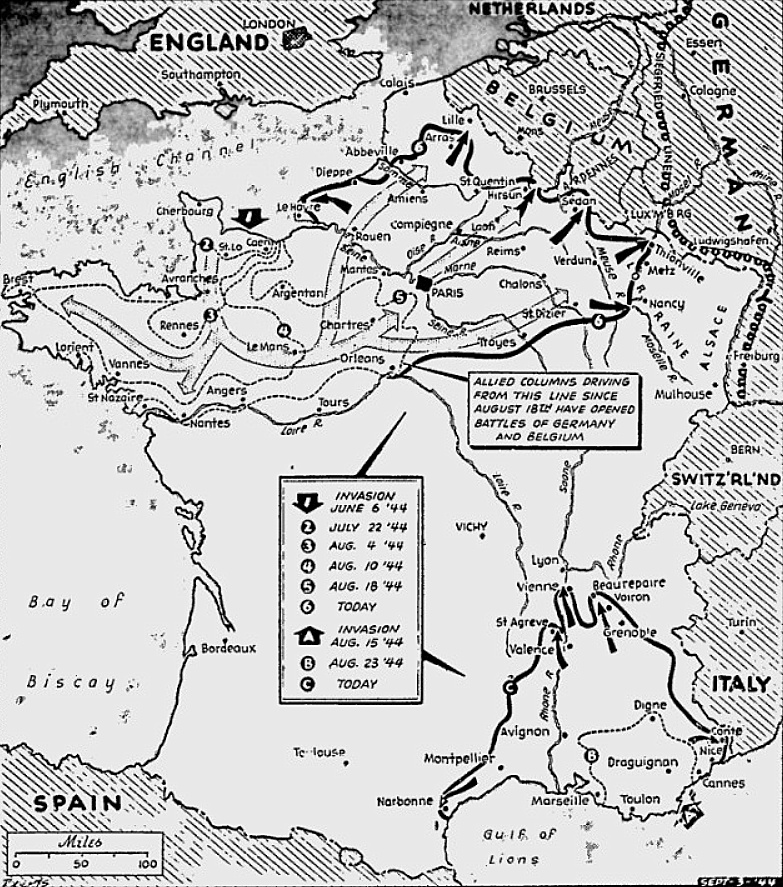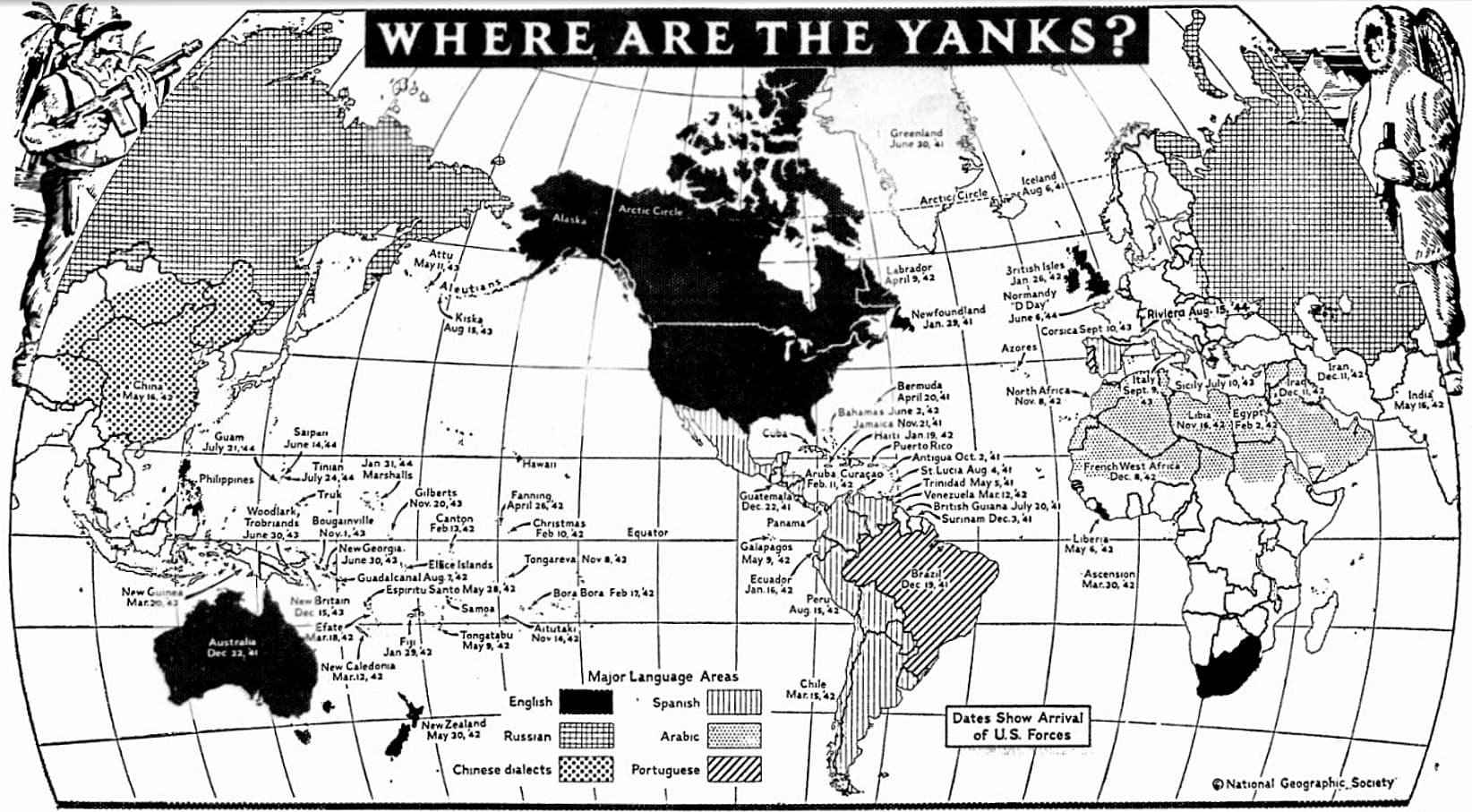The Pittsburgh Press (September 3, 1944)
AMERICANS DRIVE INTO BELGIUM
Forts in Maginot Line captured
Radio Atlantic reports Yanks also in Reich; British sweep ahead

Battle of Belgium begins as front dispatches say U.S. forces drove across the Belgium border after capturing the Maginot Line forts of Sedan and Hirson. The U.S. 3rd Army was reported to have crossed the German border near Thionville, close to Luxembourg. To the northwest, British forces smashed toward Lille. The Canadians opened a frontal attack on Le Havre and drove to within two miles of the city from the north after clearing sections of the coast to Dieppe. In southern France, Allied forces were within 14 miles of Lyon, having captured Vienne, in the Rhône Valley. Other U.S. forces reached Beaurepaire, 20 miles from Lyon. Broken lines on the map show the positions of Allied forces at various dates since the invasions.
SHAEF, London, England –
U.S. armored columns have driven across the Belgian border, front dispatches said early today, as Berlin reported another U.S. tank force has speared to Thionville on the Moselle River, only 11 miles from the German frontier.
The mystery radio station Atlantic said that Allied troops had crossed the German and Luxembourg frontiers as well as into Belgium, but there was no substantiation of the report.
The Yanks swept into Belgium after seizing the frontier forts of Hirson, Sedan and Charleville in the Maginot Line, front reports said, and other Allied columns were driving up to the border on a 100-mile front.
Front dispatches to the Exchange Telegraph reported that the Americans had crossed the Belgian border at Maubeuge, France, and near Tournai, 45 miles southeast of Brussels, and that the enemy retreat northward was completely disorganized.
Abbeville, the channel port where German armor burst through to the sea in 1940, fell to a Canadian column which had mopped up almost half of the robot bomb coast, and U.S. troops entered Compiègne after fighting through the “armistice forest” to the south.
Lt. Gen. Courtney Hodges’ 1st Army also captured the famous World War landmark of Saint-Quentin, 37 miles southeast of Arras, where the Germans launched their last great juggernaut offensive in the spring of 1918.
German broadcasts said that still another U.S. spearhead had reached Longwy, two miles from the frontier of the tiny Duchy of Luxembourg and 16 miles from Luxembourg City.
The Allies were punching relentlessly at the retreating remnants of the German armies in France along a 250-mile front and the British Army, swiftly bringing up the left flank to within 15 miles of Belgium, pounded forward in four powerful columns in gains up to 21 miles.
Overrunning Vimy Ridge, where Canadian troops fought one of their bloodiest battles in the last war, the British captured Douai, Lens, Pernes and Cambligneul and drove to within 14 miles of the great textile center of Lille, 39 miles of Calais and 35 miles of Dunkerque’s historic beaches.
One column shot out 21 miles west of Arras and captured Saint-Pol, only 320 miles from the Pas-de-Calais coast at Étaples.
Canadian 1st Army troops launched a frontal attack on the prize harbor of Le Havre, France’s second port, and crashed through its outer defenses after reaching the coast to the north, driving to within two miles of the city.
The Canucks also occupied the ports of Étretat (12 miles north of Le Havre) and Saint-Valery-en-Caux (midway between Étretat and Dieppe).
Climaxing a 60-mile march up the Rouen, the Canadian 1st Army seized three Somme River bridges at Abbeville which the Germans in their rushed retreat had left intact, completing the isolation of German garrisons and robot bomb crews in the Le Havre and other areas by passed in the advance.
With the British advance on Calais threatening to shear off the rest of the Channel coast, several small convoys attempted to evacuate key German personnel from the Pas-de-Calais Friday night, but were intercepted by British and Dutch naval craft which sank at least three vessels.
Despite a roaring gale, British Channel residents late Saturday heard a terrific explosion originating in the Boulogne area, resembling the sounds that reverberated across the strait in 1940 when the British blew up installations in the French ports. It was believed the Germans were destroying the Boulogne dock area.
Front reports said that a U.S. spearhead had reached Sedan and Charleville, respectively six and five miles from the Belgian border, while another had driven 10 miles above captured Vervins to Hirson, five miles from the border and 28 miles northwest of Charleville.
Thus, cracking the old Maginot Line at Sedan and its 1939-40 extension at Hirson and Charleville, the Yanks had battled into the head of the Ardennes Gap, reversing the invasion route into France that the Germans took in 1871, 1914, 1940.
Another significant “security blackout” overtook Lt. Gen. George S. Patton’s 3rd Army in its eastward drive, but authoritative quarters gave credibility to German reports of its progress.
Lorraine residents are being evacuated from villages in the old Maginot Line along the route of Lt. Gen. George S. Patton’s 3rd Army advance, a Berlin broadcast said.
If the Yanks had reached Thionville, which has been called Diedenhofen during its various stages of German occupancy throughout the centuries, they have penetrated German-annexed Lorraine to within 11 miles of the “pure German” frontier at Sierck, where the borders of France and Luxembourg converge with those of the Reich.
It was in this corner that the so-called “Phony War” of 1939-40 was fought between the Maginot and Siegfried Lines as the people of Luxembourg watched through their telescopes as if it were a sideshow.
An advance to Thionville would extend Gen. Patton’s front 36 miles northeast from Verdun in 24 hours, a pace that if it were maintained would put his spearheads well inside Germany by Saturday night and in front of the Siegfried or West Wall forts which lie 20 miles beyond Thionville.
More than 450 miles to the west, U.S. troops opened the second week of a grim siege of the Breton port of Brest, where a German garrison of 20,000 men was fighting to delay our use of the fine harbor.
Berlin broadcasts reported the evacuation of the Armorique Peninsula south of Brest and said the German commander of the fortress has rejected a third surrender ultimatum.
Another 20,000 Germans were reported entrenched in Lorient and Saint-Nazaire in Brittany and 2,000 others were still fighting at Le Havre, although sounds of demolitions from the latter port indicated that it would not be defended much longer.
Storms and high winds cut down on air support Saturday after a field day against jammed German retreat columns and troop trains in North France, Belgium and Holland on Friday.



